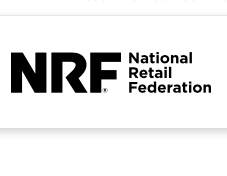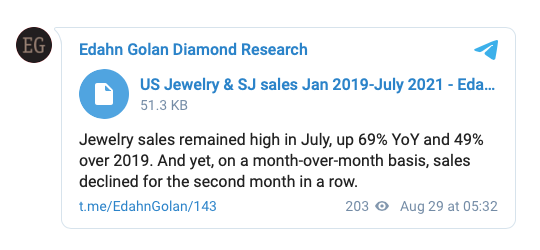Articles and News
Jewelry, General Retail Sales Both Dip In July But Demand Is Still Very Strong August 30, 2021 (0 comments)

Washington, DC—Both jewelry and general retail sales slowed slightly during July versus June, but remained solidly strong on a year-over-year basis.
The National Retail Federation said last week that data from the U.S. Census Bureau showed overall retail sales in July were down 1.1% seasonally adjusted from June, but up 15.8% from one year ago. Despite occasional month-over-month declines, sales have grown year-over-year every month since June 2020, Census data shows. June 2021 retail sales grew 0.7% month-over-month and 18.7% percent over last June.
Meanwhile, diamond industry analyst Edahn Golan said in a tweet Monday that U.S. jewelry sales remained high in July—69% over 2020 and 49% over 2019—but declined from June 2021. For general retail, the top-performing categories in July were clothing and accessories, electronics and appliances, and furniture/home furnishings.

Consumer demand remains strong, says NRF, and while the COVID-19 delta variant has spooked some shoppers, consumers are learning to live with the virus.
“July retail sales showed slight deceleration in spending, but nothing to derail our outlook for a record year,” NRF president and CEO Matthew Shay said in a statement. “Though the delta variant is presenting health challenges while supply chain disruptions along with unfilled job openings are presenting business challenges, the consumer and broader economy continue to display steady strength aided by advanced tax credit payments and strong gains in the labor market and personal incomes. We remain optimistic that the strength of the American consumer and ingenuity of the retail industry will produce continued growth heading into the fall. We encourage people to get vaccinated as soon as possible to stop the spread of the virus and to keep our economy growing.”
“Despite this monthly dip, the economy has rebounded quite well and is more than just on the mend,” NRF chief economist Jack Kleinhenz said. “The consumer has continued to be resilient and recent price increases brought on by constraints in the supply chain have not dampened the robust demand seen during the past year. If retailers could find more inventory, they could sell it. Going forward, consumers are a bit fearful again as we approach another possible wave of COVID-19 infections, but they’ve learned to live with the virus and shopping continues. The delta variant could impact local markets, especially where vaccination rates are low, but doesn’t appear likely to show up in the national data.”
Related: Vegas Generally Better than Expected Despite Estimated 40% in Last-Minute Attendance Cancellations
Kleinhenz said consumer finances are in good shape with a cushion from paying off debt and building up savings. Employment and wages have seen recent back-to-back increases, and advance child tax credit payments going out for the second month in a row should provide a bump for spending. Solid back-to-school spending contributed to July’s results and is expected to spill over into August as well.
The tax credit, part of President Joe Biden’s American Rescue Plan, means most families will receive a tax credit between $2,000 and $3,600 per child under age six and $2,000 to $3,000 per child age six to 17. The credit is applicable to all working families earning up to $150,000 per year (couple) or $112,500 (single parent/head of household).
Families who filed taxes in 2019 or 2020 or signed up to receive a stimulus check automatically received an advance on that credit in the form of monthly payments of $250-$300 per child for six months beginning July 15. They will get the rest in 2022 when they file their 2021 taxes.
In addition to the child tax credit, consumers with stock portfolios should be feeling extra flush. The S&P 500 is up 20% year to date for 2021, the Dow Jones Industrial Average is looking at a 15.6% return so far and the Nasdaq Composite Index, nearly 17%.
NRF’s calculation of retail sales – which excludes automobile dealers, gasoline stations and restaurants to focus on core retail – also showed July was down 1.1% seasonally adjusted from June, but showed that the month was up 9.5% unadjusted year-over-year. NRF’s numbers were up 13% unadjusted year-over-year on a three-month moving average and 15.5% for the first seven months of the year over the same period in 2020. That is consistent with NRF’s revised forecast that 2021 retail sales should grow between 10.5% and 13.5% over 2020.







